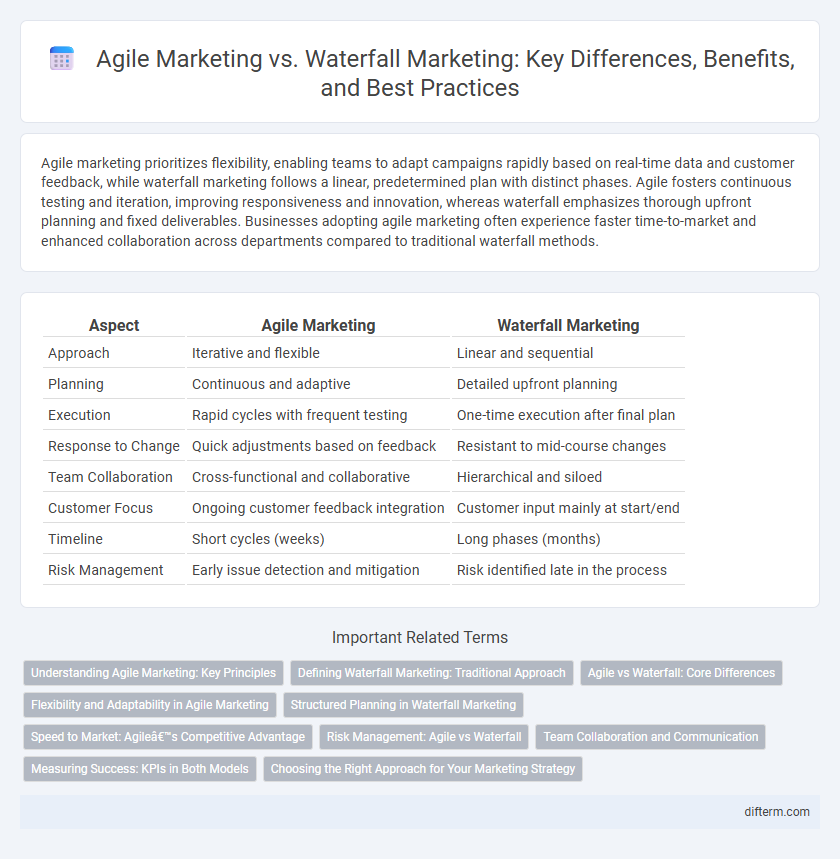Agile marketing prioritizes flexibility, enabling teams to adapt campaigns rapidly based on real-time data and customer feedback, while waterfall marketing follows a linear, predetermined plan with distinct phases. Agile fosters continuous testing and iteration, improving responsiveness and innovation, whereas waterfall emphasizes thorough upfront planning and fixed deliverables. Businesses adopting agile marketing often experience faster time-to-market and enhanced collaboration across departments compared to traditional waterfall methods.
Table of Comparison
| Aspect | Agile Marketing | Waterfall Marketing |
|---|---|---|
| Approach | Iterative and flexible | Linear and sequential |
| Planning | Continuous and adaptive | Detailed upfront planning |
| Execution | Rapid cycles with frequent testing | One-time execution after final plan |
| Response to Change | Quick adjustments based on feedback | Resistant to mid-course changes |
| Team Collaboration | Cross-functional and collaborative | Hierarchical and siloed |
| Customer Focus | Ongoing customer feedback integration | Customer input mainly at start/end |
| Timeline | Short cycles (weeks) | Long phases (months) |
| Risk Management | Early issue detection and mitigation | Risk identified late in the process |
Understanding Agile Marketing: Key Principles
Agile marketing emphasizes iterative campaigns, rapid experimentation, and cross-functional team collaboration to quickly respond to market changes and customer feedback. It operates on principles such as continuous improvement, flexibility, and value delivery in short cycles known as sprints. This approach contrasts with traditional waterfall marketing by promoting adaptability and real-time data-driven decision making for optimized campaign performance.
Defining Waterfall Marketing: Traditional Approach
Waterfall marketing is a linear, sequential approach where each phase of the marketing campaign--such as research, planning, execution, and analysis--follows a strict order without overlap or iteration. This traditional model emphasizes thorough upfront planning with clearly defined milestones and deliverables before moving to the next stage. Its structure suits projects with fixed goals and timelines but lacks the flexibility to adapt quickly to market changes or customer feedback.
Agile vs Waterfall: Core Differences
Agile marketing emphasizes iterative campaigns, cross-functional collaboration, and rapid adaptability compared to the linear, sequential phases of Waterfall marketing. Agile teams frequently test and optimize strategies based on real-time data, while Waterfall relies on extensive upfront planning and fixed timelines. This flexibility enables Agile marketing to respond swiftly to market changes and customer feedback, contrasting with Waterfall's structured, rigid execution approach.
Flexibility and Adaptability in Agile Marketing
Agile marketing offers superior flexibility by enabling teams to rapidly adjust strategies based on real-time data and consumer feedback, contrasting with the rigid, linear structure of waterfall marketing. This adaptability allows marketers to respond quickly to market trends and changing customer needs, ensuring campaigns remain relevant and effective. Consequently, Agile marketing enhances project outcomes by fostering continuous improvement and iterative testing throughout the campaign lifecycle.
Structured Planning in Waterfall Marketing
Waterfall marketing relies on structured planning through clearly defined phases, ensuring each stage--research, strategy, execution, and evaluation--follows a linear, sequential order. This approach emphasizes comprehensive documentation and upfront goal-setting, enabling precise resource allocation and predictable timelines. Structured planning in waterfall marketing offers stability and control, which is beneficial for campaigns with fixed budgets and clear objectives.
Speed to Market: Agile’s Competitive Advantage
Agile marketing accelerates Speed to Market by enabling iterative campaigns and rapid feedback loops, reducing time from concept to execution by up to 30%. Unlike waterfall marketing's linear phases, Agile's flexible sprints allow teams to adapt strategies in real-time based on consumer insights and market trends. This responsiveness provides a competitive advantage by ensuring faster delivery of impactful marketing initiatives that resonate with target audiences.
Risk Management: Agile vs Waterfall
Agile marketing excels in risk management through iterative testing and real-time feedback, allowing teams to quickly identify and address potential issues before full-scale implementation. In contrast, Waterfall marketing relies on a linear, sequential approach that often delays risk detection until later stages, increasing the likelihood of costly project overruns. Agile's adaptability reduces uncertainty by promoting continuous assessment and rapid course correction, which is less feasible in the rigid Waterfall framework.
Team Collaboration and Communication
Agile marketing enhances team collaboration and communication by promoting continuous feedback loops and iterative workflows, enabling faster adjustments based on real-time data. Waterfall marketing follows a linear, sequential process that can limit dynamic interaction among team members until project milestones are reached. Agile's emphasis on cross-functional teams and transparent communication tools drives more adaptive and cohesive marketing strategies.
Measuring Success: KPIs in Both Models
Agile marketing emphasizes real-time tracking of KPIs such as customer engagement, conversion rates, and campaign adaptability to quickly iterate and optimize strategies. Waterfall marketing relies on predefined KPIs like budget adherence, timeline milestones, and overall ROI to evaluate success at the project's completion. Both models prioritize KPIs but differ in flexibility and timing, with Agile supporting continuous measurement and Waterfall focusing on end-stage assessment.
Choosing the Right Approach for Your Marketing Strategy
Agile marketing emphasizes iterative campaigns, rapid testing, and adaptability to real-time customer feedback, enhancing responsiveness and innovation in dynamic markets. Waterfall marketing follows a linear, stage-based process ideal for projects with clear objectives, fixed timelines, and predictable outcomes. Selecting the right approach depends on your team's flexibility, project complexity, and the market environment, balancing speed with thorough planning.
Agile marketing vs waterfall marketing Infographic

 difterm.com
difterm.com